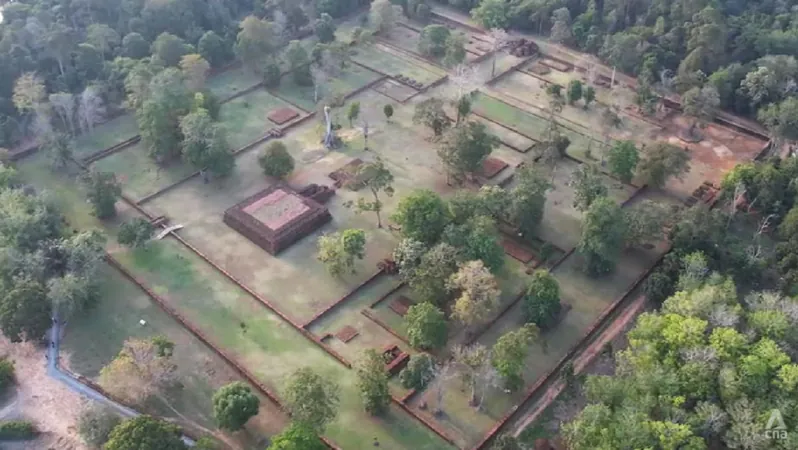
Indonesia's Hidden Gems: The Revival of Muarajambi Temple Complex Sparks a Cultural Renaissance
2024-12-30
Author: Rajesh
Introduction
JAMBI PROVINCE, Sumatra: The Indonesian government is unleashing its efforts to breathe new life into the lesser-known jewels of its cultural heritage, most notably the Muarajambi temple complex. This temple is not just another historical site; it stands as one of the largest Buddhist constructions in the world, dwarfing even the famous Borobudur by twentyfold.
Historical Significance
Dating back to between the 6th and 13th centuries, the Muarajambi complex flourished during the era of the Sriwijaya and Malay kingdoms, which were highly regarded for their advanced cultures. Archaeologists believe the grand layout and intricate design of the complex indicate it was a pivotal center for Buddhist education and spiritual practices, advantageously placed to attract monks and scholars.
Revitalization Efforts
On the forefront of this ambitious revitalization is Agus Widiatmoko, the head archaeologist at the Heritage Preservation Office (Region 5), who passionately advocates for opening the site to the public. “When we revitalize it, we anticipate an influx of visitors, particularly the youth and older generations who are eager to connect with our rich historical identity,” he remarked. “It’s vital for current and future generations to recognize our nation’s greatness long before the onset of European colonization.”
UNESCO World Heritage Status
The Muarajambi temple complex was added to UNESCO's World Heritage Tentative List in 2009, and its significance received renewed attention in 2022 following a visit from Indonesia’s former President Joko Widodo. Since then, directives have been established for its revitalization, but turning this dream into reality poses a multitude of challenges, notably in terms of resources and funding.
Challenges Faced
Former Indonesian director general of culture, Hilmar Faris, highlighted the difficulties posed by the region’s economic focus on mining and palm oil, which often overshadows cultural preservation. The imminent threats of climate change further complicate preservation efforts, creating an urgent call for integrated solutions. Despite these obstacles, the new administration is determined to secure the coveted UNESCO World Heritage status for Muarajambi.
Future Plans
Revitalization works are expected to unfold over the next 15 years. The complex encompasses over 115 structures, with roughly 82 historical sites still veiled beneath earth and debris. Among the notable findings is an ancient well that dates back over 600 years, complemented by a trove of artifacts that paint a picture of Jambi’s glorious past.
Cultural Engagement
To enhance engagement, authorities are planning the construction of a museum that will showcase not only artifacts but also provide platforms for contemporary artists and academic research relating to architecture, botany, and culture. This initiative aims to transform Muarajambi into an educational powerhouse, securing its identity as a key player in Indonesia’s cultural heritage narrative.
Culinary Experience
Additionally, the local Paduka community is doing its part to enliven the area’s cultural landscape through gastronomic offerings. Previously limited to snacks and beverages, they have embraced a more immersive culinary experience that highlights local flavors and spices. Sartini, the community leader, shared, “Through training, we’ve learned to bring what we love to the table for visitors, connecting them to Muarajambi’s rich culinary heritage and supporting our families.”
Economic Potential
The revival efforts have sparked economic interest, although there is consensus among tourism observers that more work lies ahead. Abdul Hafiz, chairman for Jambi province at the Indonesian Tour Guide Association, emphasized, “We aim for quality over quantity. It’s not about thousands of visitors spending a little, but rather a select few willing to invest significantly, contributing to sustainable tourism that benefits the community.”
Conclusion
As Indonesia embarks on this journey of rediscovery, the Muarajambi temple complex is poised not only to capture the imagination of future generations but also to reaffirm Indonesia’s status as a treasure chest of cultural heritage waiting to be explored. What awaits curious travelers and history buffs alike is an unparalleled experience that intertwines spirituality, ancient knowledge, and rich culinary traditions, underlining the nation's cultural significance long lost to the sands of time.
 Brasil (PT)
Brasil (PT)
 Canada (EN)
Canada (EN)
 Chile (ES)
Chile (ES)
 Česko (CS)
Česko (CS)
 대한민국 (KO)
대한민국 (KO)
 España (ES)
España (ES)
 France (FR)
France (FR)
 Hong Kong (EN)
Hong Kong (EN)
 Italia (IT)
Italia (IT)
 日本 (JA)
日本 (JA)
 Magyarország (HU)
Magyarország (HU)
 Norge (NO)
Norge (NO)
 Polska (PL)
Polska (PL)
 Schweiz (DE)
Schweiz (DE)
 Singapore (EN)
Singapore (EN)
 Sverige (SV)
Sverige (SV)
 Suomi (FI)
Suomi (FI)
 Türkiye (TR)
Türkiye (TR)
 الإمارات العربية المتحدة (AR)
الإمارات العربية المتحدة (AR)